Amlodac D Tablet 10's

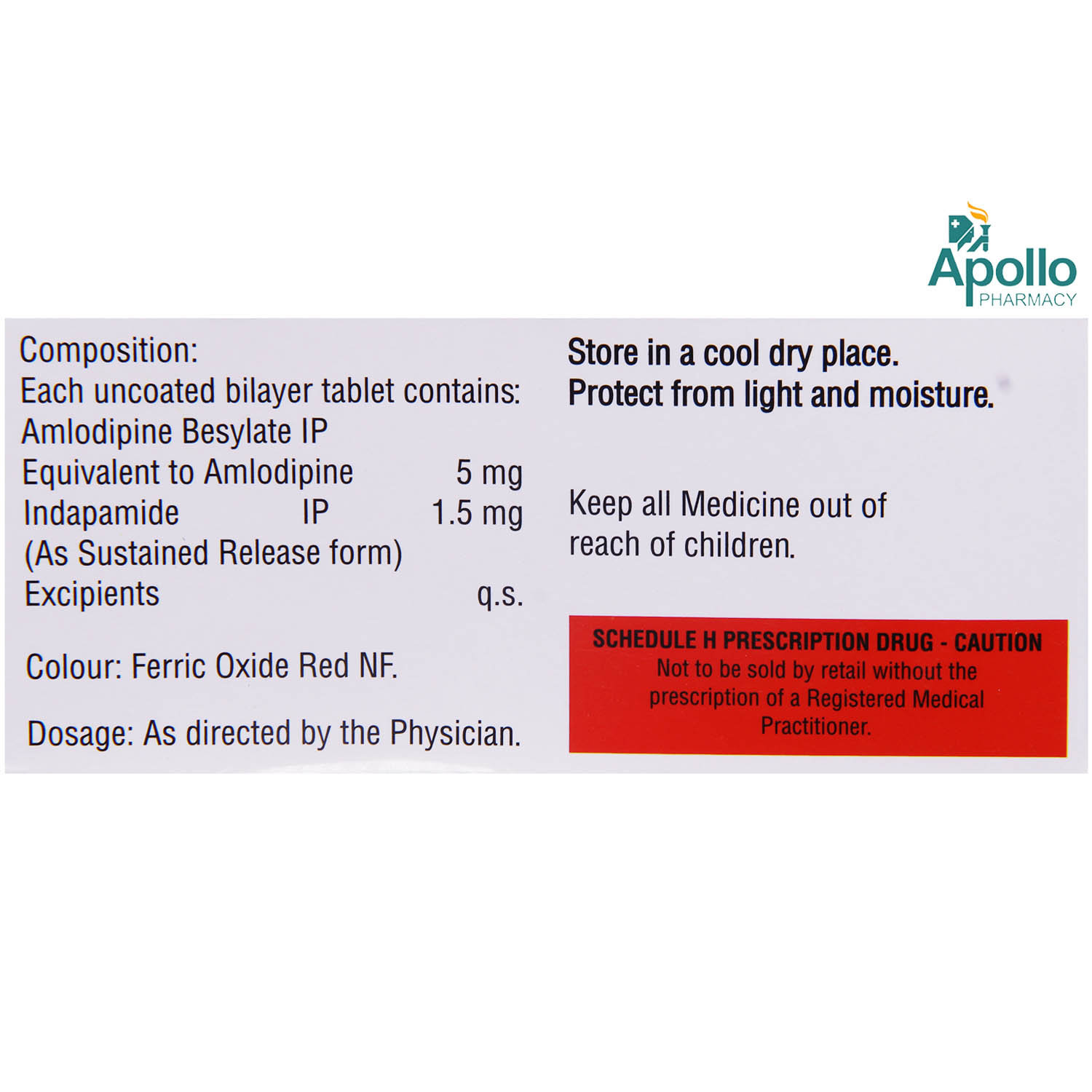
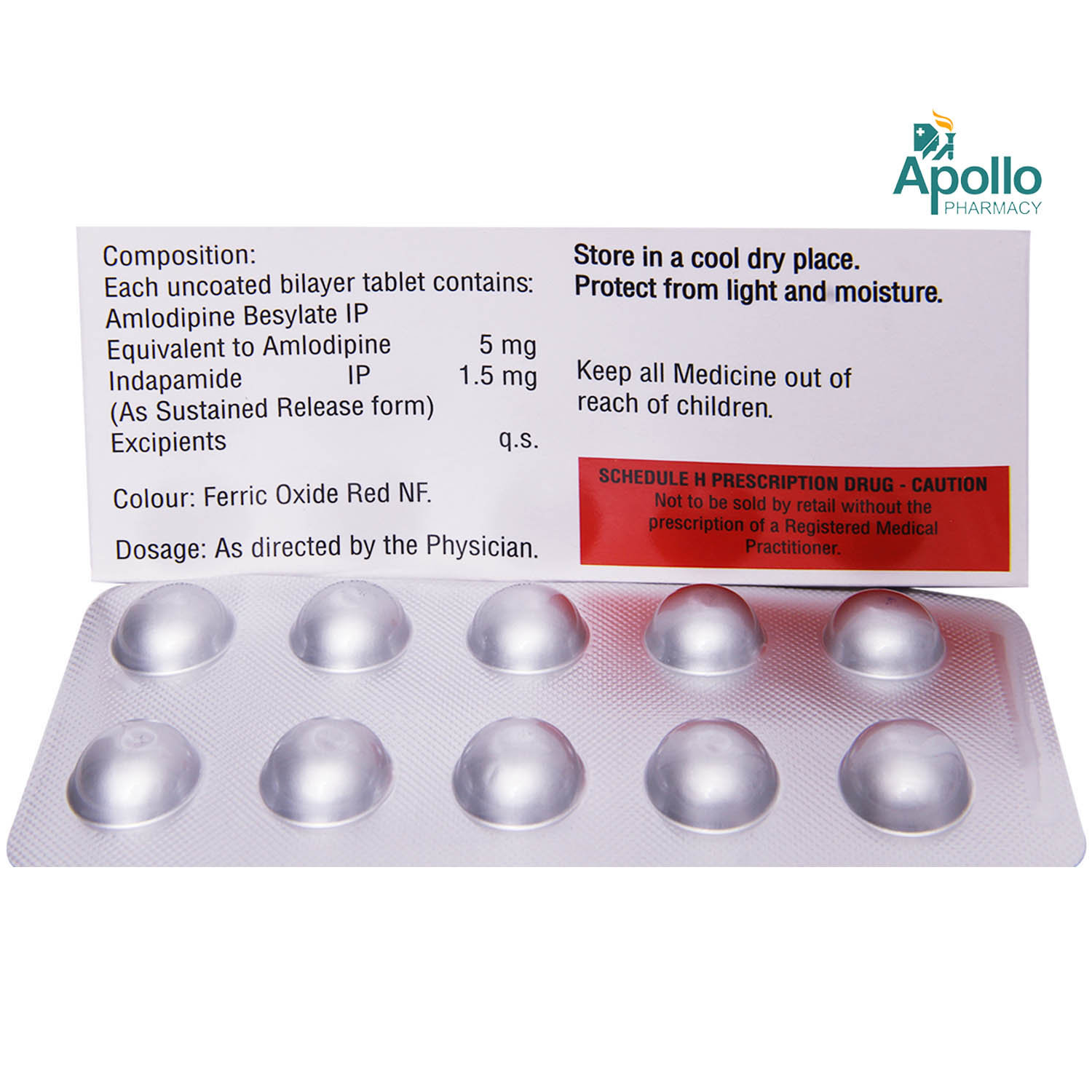
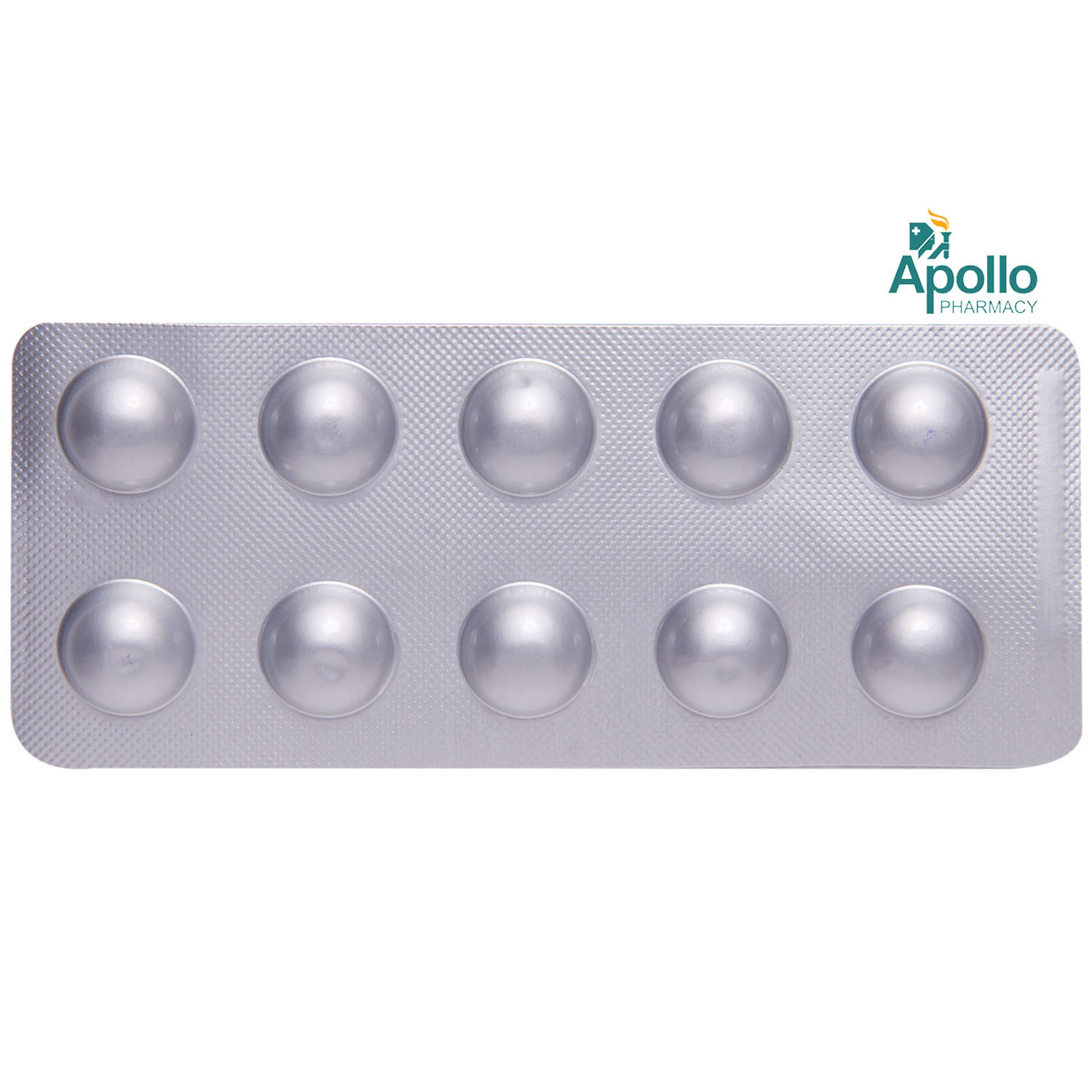
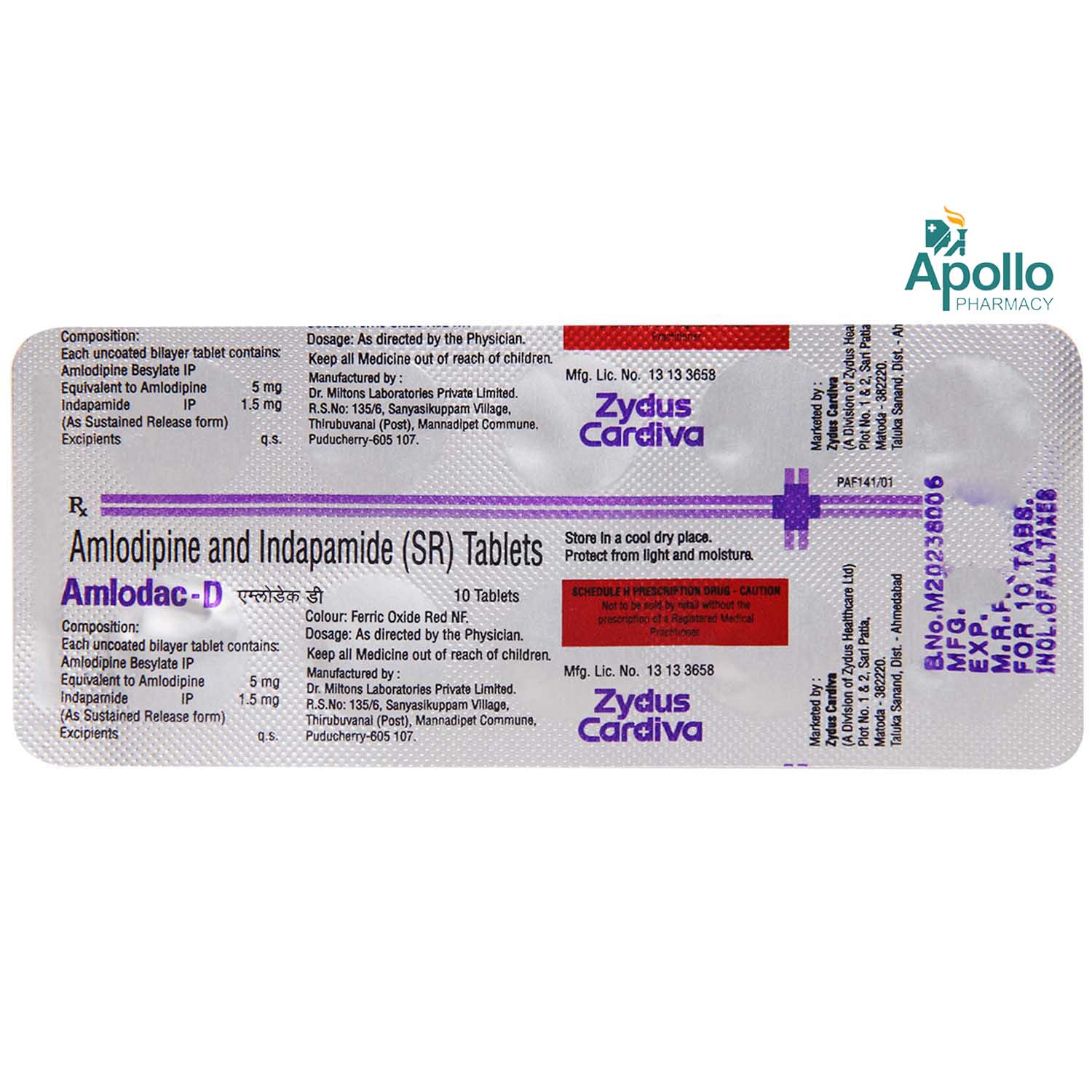
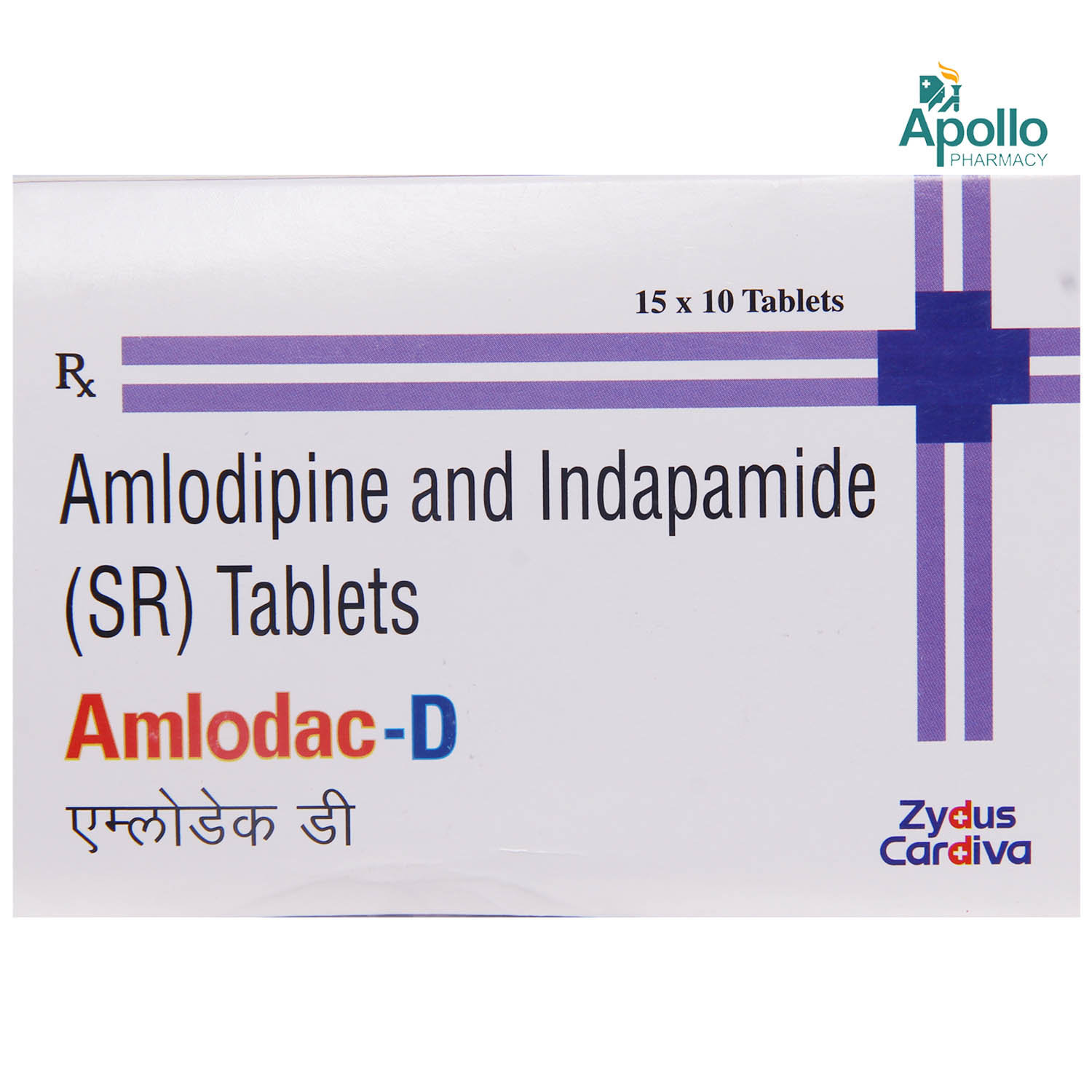




MRP ₹156
(Inclusive of all Taxes)
₹23.4 Cashback (15%)
Provide Delivery Location
Online payment accepted
 Prescription drug
Prescription drugWhats That
Composition :
Manufacturer/Marketer :
Consume Type :
Return Policy :
Expires on or after :
About Amlodac D Tablet
Amlodac D Tablet belongs to the class of medication called 'anti-hypertensive drugs', primarily used to treat hypertension (high blood pressure). Hypertension is a medical condition in which the blood exerts high pressure (force exerted by circulating blood) against the blood vessel's walls. This condition makes the heart work harder in pumping blood to the whole body. Hypertension can cause severe health complications, including stroke, heart failure, heart attack and kidney failure.
Amlodac D Tablet consists of Amlodipine and Indapamide. Amlodipine relaxes blood vessels so that blood passes through them easily, thereby lowering blood pressure. Indapamide inhibits excess salt absorption in the body, resulting in increased chloride, sodium, and water excretion through urine. This diuresis process (increased urine production) and excess salts and fluid removal help lower blood pressure.
The common side effects of Amlodac D Tablet include nausea, stomach pain, headache, sleepiness, ankle swelling, flushing (warm sensation in the face, ears, neck, and trunk), palpitations (pounding heartbeat), constipation, muscle pain, and tiredness. Most of these side effects resolve gradually over time and do not usually require medical attention. However, if you notice any side effects that are not manageable, it is advised to consult your doctor.
Try not to stop taking this medicine on your own. Stopping Amlodac D Tablet may worsen your condition and increase the risk of a heart attack. Tell your doctor if you are sensitive to Amlodac D Tablet , have any kidney/liver diseases, or have heart problems like aortic/mitral stenosis (reduced blood flow from the left atrium to the left ventricle due to narrowing of the mitral valve). Amlodac D Tablet is not recommended for use in pregnancy and breastfeeding. Amlodac D Tablet may cause dizziness; hence it is advised to drive only when you are alert.
Uses of Amlodac D Tablet
Directions for Use
Medicinal Benefits
Amlodac D Tablet is composed of two medicines, namely: Amlodipine and Indapamide. Amlodipine belongs to the class of calcium channel blockers that relaxes blood vessels so that blood passes through them easily, lowering blood pressure. Indapamide is a thiazide diuretic that inhibits excess salt absorption in the body, resulting in increased chloride, sodium, and water excretion through urine. This diuresis process (increased urine production) and excess salts and fluid removal help lower blood pressure.
Storage
- Hydrate your body: Drink enough water to prevent dehydration and headaches.
- Calm Your Mind: Deep breathing and meditation can help you relax and relieve stress.
- Rest and Recharge: Sleep for 7-8 hours to reduce headache triggers.
- Take rest: lie down in a quiet, dark environment.
- Cold or warm compresses can help reduce tension.
- Stay Upright: Maintain good posture to keep symptoms from getting worse.
- To treat headaches naturally, try acupuncture or massage therapy.
- Over-the-counter pain relievers include acetaminophen and ibuprofen.
- Prescription Assistance: Speak with your doctor about more substantial drug alternatives.
- Severe Headaches: Seek emergency medical assistance for sudden, severe headaches.
- Frequent Headaches: If you get reoccurring headaches, consult your doctor.
- Headaches with Symptoms: Seek medical attention if your headaches include fever, disorientation, or weakness.
- Inform your doctor about dizziness symptoms. They may adjust your medication regimen or prescribe additional medications to manage symptoms.
- Follow your doctor's instructions for taking medication, and take it at the same time every day to minimize dizziness.
- When standing up, do so slowly and carefully to avoid sudden dizziness.
- Avoid making sudden movements, such as turning or bending quickly, which can exacerbate dizziness.
- Drink plenty of water throughout the day to stay hydrated and help alleviate dizziness symptoms.
- If you're feeling dizzy, sit or lie down and rest until the dizziness passes.
- Track when dizziness occurs and any factors that may trigger it, and share this information with your doctor to help manage symptoms.
- Avoid triggers like alcohol, caffeine, and energy drinks.
- Try relaxation techniques such as yoga, meditation, or deep breathing.
- Exercise regularly as it helps maintain heart health.
- Follow a nutritious and balanced diet.
- Drink water or other clear fluids.
- To prevent worsening of pain, limit intake of tea, coffee, or alcohol.
- Include bland foods like rice, toast, crackers, and rice in your diet.
- Avoid lying down immediately after eating as it may cause indigestion or heartburn.
- Avoid acidic and spicy food as it may cause indigestion.
- Drink fluids: Water, clear broth, or electrolyte-rich beverages.
- Follow a balanced diet, which would be rich in fruits, vegetables, whole grains, lean proteins, and healthy fats.
- Mindfulness: Manage stress with meditation, deep breathing or yoga.
- Stay away from smoke, dust and other irritants.
- Get adequate rest to facilitate recovery.
- Wash hands and avoid close contact, do not share personal items.
Drug Warnings
Do not use Amlodac D Tablet if you are allergic to any of its components. Let your doctor know if you have any history of severe kidney or liver diseases, low potassium levels (hypokalaemia), chest pain (angina), poor blood circulation or controlled heart failure, first-degree heart block, diabetes, thyrotoxicosis (a condition caused by an overactive thyroid gland), liver problems and adrenal gland diseases. Let your doctor know if you have anuria (kidneys aren't producing urine), fluid or electrolyte imbalance, lupus erythematosus (an autoimmune inflammatory disease-causing scaly red patches on the skin), gout, abnormal heart rhythms, thyroid disorders or asthma. Consult your doctor if you are pregnant or breastfeeding. Amlodac D Tablet can increase the chances of light-headedness, so rise slowly if you are sitting/lying and avoid operating any machine or doing any work that needs mental alertness. Amlodac D Tablet is not recommended in people less than 18 years of age.
Drug-Drug Interactions
Drug-Drug Interactions
Login/Sign Up
Using Amlodac D Tablet together with dantrolene may increase the risk of hyperkalemia (high blood potassium).
How to manage the interaction:
Taking Amlodac D Tablet with Dantrolene can cause an interaction, consult a doctor before taking it. You should seek medical attention if you experience nausea, vomiting, weakness, confusion, tingling of the hands and feet, a weak pulse, or a slow or irregular heartbeat. Do not stop using any medications without talking to a doctor.
Taking Droperidol with Amlodac D Tablet can lead to severe heart problems.
How to manage the interaction:
Taking Droperidol with Amlodac D Tablet is not recommended, but can be taken if prescribed by the doctor.
Taking Protriptyline along with Amlodac D Tablet can lead to serious heart problems.
How to manage the interaction:
Taking Protriptyline with Amlodac D Tablet is not recommended, but can be taken if prescribed by the doctor.
Taking Amlodac D Tablet with Thioridazine can increase the risk of heart problems.
How to manage the interaction:
Taking Thioridazine with Amlodac D Tablet is not recommended, but can be taken if prescribed by the doctor.
Using Amlodac D Tablet and mitotane together may drastically lower Amlodac D Tablet blood levels, which makes the medicine less effective.
How to manage the interaction:
Although co-administration of Amlodac D Tablet with mitotane can result in an interaction, it can be taken if a doctor has advised it. Do not discontinue any medications without consulting a doctor.
Using phenobarbital and Amlodac D Tablet may drastically lower Amlodac D Tablet blood levels, which makes the medicine less effective.
How to manage the interaction:
Although co-administration of phenobarbital with Amlodac D Tablet can result in an interaction, it can be taken if a doctor has advised it. Do not discontinue any medications without consulting a doctor.
Coadministration of Amlodac D Tablet and carbamazepine together may significantly reduce Amlodac D Tablet blood levels, making the medicine less effective.
How to manage the interaction:
Although there is an interaction between Amlodac D Tablet with carbamazepine, it can be taken if a doctor has advised it. However, if you experience any unusual symptoms contact the doctor immediately. Do not stop using any medications without talking to a doctor.
Using Amlodac D Tablet and phenytoin together may drastically lower Amlodac D Tablet blood levels, which makes the medicine less effective.
How to manage the interaction:
Although Amlodac D Tablet with phenytoin can result in an interaction, it can be taken if a doctor has advised it. Do not discontinue any medications without consulting a doctor.
Using Amlodac D Tablet and primidone together may lower Amlodac D Tablet blood levels, which makes the medicine less effective.
How to manage the interaction:
Although co-administration of Amlodac D Tablet with primidone can result in an interaction, it can be taken if a doctor has advised it. Do not discontinue any medications without consulting a doctor.
Coadministration of lemborexant and Amlodac D Tablet may increase the blood levels of lemborexant.
How to manage the interaction:
Although co-administration of Amlodac D Tablet with Lemborexant can result in an interaction, it can be taken if a doctor has advised it. However, consult your doctor if you experience abnormal sleep patterns, worsening of depression, changes in heartbeat, or headache. Do not discontinue any medications without consulting a doctor.
Drug-Food Interactions
Drug-Food Interactions
Login/Sign Up
Grapefruit, Grapefruit Juice
How to manage the interaction:
Consumption of grapefruit and grapefruit juice along with Indapamide and Amlodipine the levels of Indapamide and Amlodipine in your bloodstream may drop. Avoid consuming a lot of grapefruit and grapefruit juice when using Amlodac D Tablet, instead, take it with water. As a result, your body will absorb the drug more easily.
Diet & Lifestyle Advise
- Keep your weight under control with a body mass index (BMI) between 19.5 and 24.9.
- Quit smoking to lower the risk of heart disease.
- Avoid chronic stress, as it can raise your blood pressure. Try to enjoy and spend time with your loved ones to cope with stress.
- Monitor your blood pressure daily, and if you notice any fluctuations frequently, please get in touch with your doctor immediately.
- Try including heart-healthy omega-3 fatty acid-containing foods in your daily diet. You can also use low-fat cooking oils like olive oil, soybean oil, canola oil, and coconut oil that help in lowering your elevated blood pressure.
Side Effects of Amlodac D Tablet
- Blurred Vision
- Sweating
- Tiredness
- Dehydration
- Constipation
- Dizziness
- Headache
- Nausea
- Cold hands or feet
- Muscle cramps
- Difficulty breathing
- Tightness in the chest
Habit Forming
Therapeutic Class
All Substitutes & Brand Comparisons
Drug-Diseases Interactions
Drug-Diseases Interactions
Login/Sign Up
FAQs
Amlodac D Tablet is recommended to use in dose and duration as advised by the doctor. Do not stop taking Amlodac D Tablet on your own, as it may lead to a sudden rise in blood pressure and increases the risk of heart attack and stroke.
Amlodac D Tablet can cause dehydration and dry mouth. Drink plenty of fluids and let your doctor know if you develop extreme thirst, muscle weakness or a very dry mouth.
Amlodac D Tablet can cause dizziness as one of its side effects. If you feel dizzy, try getting up slowly from a sitting or lying position. If your dizziness is severe or unmanageable, please seek medical advice.
It is advised to consult your doctor before taking Amlodac D Tablet if you have a history of severe kidney or liver diseases, low potassium levels (hypokalaemia), diabetes, gout, abnormal heart rhythms, thyroid disorders and asthma.
It is recommended to consult your doctor since diuretics (water pills) may increase blood sugar levels. Besides this, beta-blockers (blood pressure-lowering agents) can mask hypoglycemia symptoms (low blood sugar).
Even though your blood pressure becomes normal after using Amlodac D Tablet , it may switch back to high ranges if you stop using it. Your doctor may change the dosing schedule based on your blood pressure range.
Drug-Drug Interactions Checker List
- SILDENAFIL
- OXYCODONE
- PREDNISONE
- CLONAZEPAM
- ESOMEPRAZOLE
- INSULIN GLARGINE
- METFORMIN
- CHOLECALCIFEROL
- RISPERIDONE
- DULOXETINE
- DIGOXIN
- AMIODARONE
- LISINOPRIL
- CANDESARTAN
- LITHIUM
- NAPROXEN
- AMISULPRIDE
- IBUPROFEN
- PIMOZIDE
- ALPRAZOLAM
- CLONIDINE
- BACLOFEN
- LEVODOPA
- METOPROLOL
- CHLORTHALIDONE
- HYDROCHLOROTHIAZIDE
- FUROSEMIDE
- TORSEMIDE
- RAMIPRIL
Special Advise
- Monitor your blood pressure regularly and seek medical advice if you notice any drastic fluctuations.
- Let your doctor know if you are advised for any blood examinations as diuretics like Indapamide can cause changes in the laboratory parameters like low potassium levels in the blood, low sodium in the blood, low blood pressure, increase in uric acid, increase in blood glucose levels in diabetic patients, increase in calcium levels in the blood, and increase in the liver enzyme levels.
- Let your anaesthetist or medical staff know that you are taking Amlodac D Tablet since Amlodac D Tablet can lower blood pressure levels when certain anaesthetic medications are given during any operation or surgery.
- Athletes should be aware that Indapamide in Amlodac D Tablet gives a positive reaction in doping tests.
Disease/Condition Glossary
Hypertension: When blood pressure is excessively high, it becomes a chronic problem. Blood pressure is determined by how much blood the heart pumps and how much resistance the arteries provide to the flow of blood. Blood pressure rises, and arteries constrict as the heart pumps more blood. If not treated, uncontrolled blood pressure can cause major cardiac conditions, including heart attack and stroke. Kidney failure and brain damage are two more effects of high blood pressure. Headache, bleeding from the nose, nausea, and chest discomfort are a few signs of hypertension.

Have a query?
Buy best Cardiology products by
Torrent Pharmaceuticals Ltd
Sun Pharmaceutical Industries Ltd
Lupin Ltd
Intas Pharmaceuticals Ltd
Cipla Ltd
Micro Labs Ltd
Macleods Pharmaceuticals Ltd
Abbott India Ltd
Ajanta Pharma Ltd
Ipca Laboratories Ltd
Eris Life Sciences Ltd
Mankind Pharma Pvt Ltd
Lloyd Healthcare Pvt Ltd
Dr Reddy's Laboratories Ltd
Glenmark Pharmaceuticals Ltd
Emcure Pharmaceuticals Ltd
Alembic Pharmaceuticals Ltd
Alkem Laboratories Ltd
East West Pharma India Pvt Ltd
USV Pvt Ltd
Zydus Healthcare Ltd
Aristo Pharmaceuticals Pvt Ltd
Elbrit Life Sciences Pvt Ltd
J B Chemicals & Pharmaceuticals Ltd
Zydus Cadila
Akumentis Healthcare Ltd
Alteus Biogenics Pvt Ltd
Hbc Life Sciences Pvt Ltd
Fusion Health Care Pvt Ltd
Troikaa Pharmaceuticals Ltd
La Renon Healthcare Pvt Ltd
Corona Remedies Pvt Ltd
Jubilant Lifesciences Ltd
Medley Pharmaceuticals Ltd
Knoll Healthcare Pvt Ltd
Msn Laboratories Pvt Ltd
Zuventus Healthcare Ltd
Cadila Pharmaceuticals Ltd
Blue Cross Laboratories Pvt Ltd
Lividus Pharmaceuticals Pvt Ltd
Morepen Laboratories Ltd
Ranmarc Labs
Shrrishti Health Care Products Pvt Ltd
Sanofi India Ltd
Steris Healthcare
Elder Pharmaceuticals Ltd
Primus Remedies Pvt Ltd
Unison Pharmaceuticals Pvt Ltd
Eswar Therapeutics Pvt Ltd
Knoll Pharmaceuticals Ltd
Tas Med India Pvt Ltd
Systopic Laboratories Pvt Ltd
Indiabulls Pharmaceuticals Pvt Ltd
Leeford Healthcare Ltd
Sinsan Pharmaceuticals Pvt Ltd
Biochem Pharmaceutical Industries Ltd
Cadila Healthcare Ltd
Azkka Pharmaceuticals Pvt Ltd
Nirvana India Pvt Ltd
Orsim Pharma
Prevego Healthcare & Research Pvt Ltd
Econ Healthcare
Elinor Pharmaceuticals (P) Ltd
FDC Ltd
Sunij Pharma Pvt Ltd
Nicholas Piramal India Ltd
Astra Zeneca Pharma India Ltd
Pfizer Ltd
Lia Life Sciences Pvt Ltd
Shine Pharmaceuticals Ltd
Elicad Pharmaceuticals Pvt Ltd
Indoco Remedies Ltd
Proqol Health Care Pvt Ltd
Vasu Organics Pvt Ltd
Biocon Ltd
Opsis Care Lifesciences Pvt Ltd
Johnlee Pharmaceuticals Pvt Ltd
Merck Ltd
Wockhardt Ltd
Auspharma Pvt Ltd
Ergos Life Sciences Pvt Ltd
Lakshya Life Sciences Pvt Ltd
Ordain Health Care Global Pvt Ltd
Pficus De Med Pvt Ltd
ALICAN PHARMACEUTICAL PVT LTD
RPG Life Sciences Ltd
Glynis Pharmaceuticals Pvt Ltd
Orris Pharmaceuticals
Samarth Life Sciences Pvt Ltd
Aprica Pharmaceuticals Pvt Ltd
Aretaeus Pharmaceuticals Pvt Ltd
Koye Pharmaceuticals Pvt Ltd
Neocardiab Care
Retra Life Science Pvt Ltd
Alniche Life Sciences Pvt Ltd
Alvio Pharmaceuticals Pvt Ltd
Arkas Pharma Pvt Ltd
Atos Lifesciences Pvt Ltd
Divine Savior Pvt Ltd
Metalis Lifesciences Pvt Ltd
Alcohol
Caution
Alcohol may lower your blood pressure. It would help if you avoid or limit consuming alcohol whilst taking this medicine.
Pregnancy
Caution
Indapamide in Amlodac D Tablet is not recommended during pregnancy. However, seek medical advice before using Amlodac D Tablet if you plan to conceive or are pregnant.
Breast Feeding
Caution
There are limited studies on how Amlodac D Tablet affects breastfed infants. However, Indapamide in Amlodac D Tablet may pass into the breast milk during breastfeeding. Please consult your doctor before using Amlodac D Tablet if you are a lactating mother.
Driving
Caution
Amlodac D Tablet may cause side effects such as dizziness or tiredness. If you feel dizzy or tired when taking this medicine, do not drive or use any tools or machines.
Liver
Caution
Let your doctor know if you have any history of liver diseases before using Amlodac D Tablet .
Kidney
Caution
Let your doctor know if you have any history of kidney diseases before using Amlodac D Tablet .
Children
Unsafe
Amlodac D Tablet is not recommended for use in people below 18 years of age.
Recommended for a 30-day course: 3 Strips



